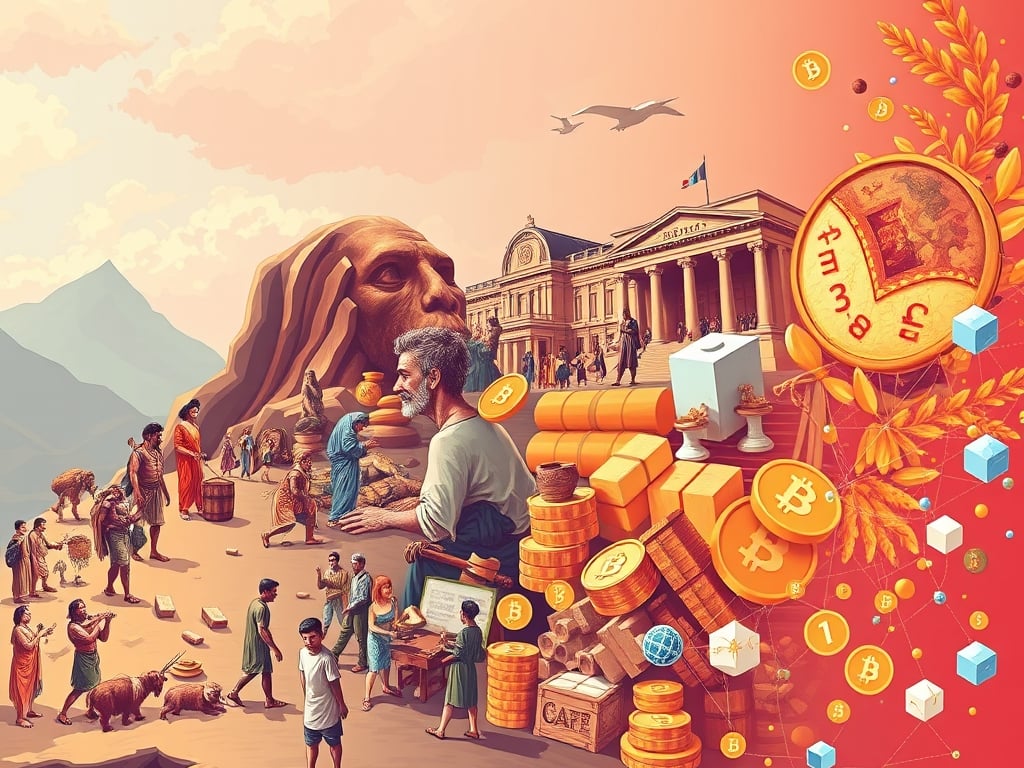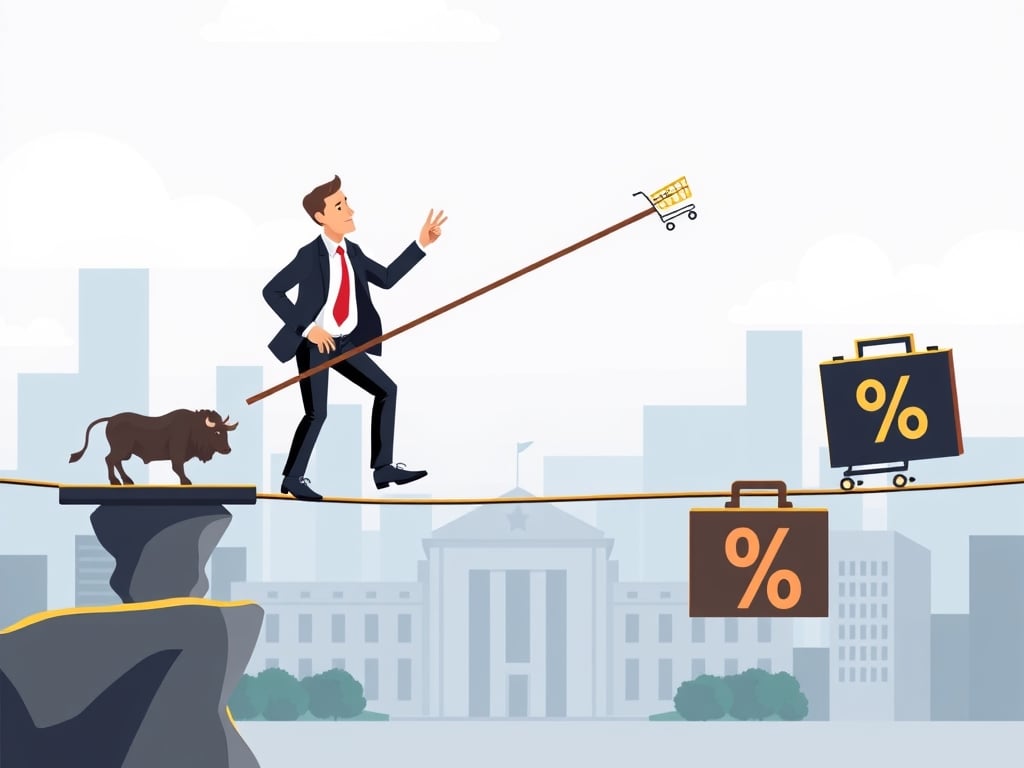The Evolution of Asset Exchange: From Barter Systems to Blockchain-Based Asset Tokenization
This report provides a comprehensive examination of the evolution of asset exchange, tracing its historical roots from primitive barter systems through the development of standardized currencies and securities, culminating in the modern era of blockchain-driven asset tokenization. By integrating insights from extensive research, this report details the transformative journey of how real-world assets—ranging from real estate and art to equity—are being reimagined as digital tokens on blockchain platforms. The narrative outlines the impacts on asset liquidity, market accessibility, and overall financial innovation.
1. Historical Trajectory of Asset Exchange
1.1. Primitive Barter Systems and the Advent of Standardized Currency
Economic transactions have evolved considerably over centuries. In early civilizations such as Mesopotamia and Ancient Egypt, barter systems prevailed in which goods like salt and cattle were exchanged directly—often driven by the intrinsic value of high-demand commodities. Notably, these early economies set the groundwork for formal trade by emphasizing the need for mutually recognized value.
A pivotal evolution occurred with the introduction of standardized coinage. For example, regions such as Lydia (circa 7th century BC) pioneered uniform value representations in transactions, which was later expanded on during the Tang dynasty and the European Renaissance. Standardization in coin-based currencies simplified the trading process and laid a fundamental foundation for more intricate systems of exchange.
1.2. Emergence of Securities and Structured Financial Markets
The evolution of asset exchange did not halt at the innovation of currency. By the 17th and 18th centuries, a transition occurred from straightforward asset trading to trading complex financial instruments. The establishment of institutions such as London's Royal Exchange and the Amsterdam Stock Exchange in 1602 formalized securities markets, while the New York Stock Exchange (founded in 1792) cemented the practice of organized trading.
This period was characterized by the emergence of diversified financial instruments allowing for risk management and capital formation. Institutionalized practices and standardized settlement procedures evolved to meet the needs of a rapidly expanding global economy, firmly establishing the foundations of modern securities markets.
2. The Digital Transformation: Blockchain and Tokenization
2.1. The Birth of Blockchain Technology
The narrative of asset exchange took a revolutionary turn with the advent of blockchain technology post-2008. Bitcoin, introduced in 2009, marked the emergence of decentralized, cryptographically-secured transactions. Subsequently, Ethereum (launched in 2015) expanded blockchain’s capabilities by introducing programmable smart contracts—paving the way for more advanced applications such as asset tokenization.
2.2. Concepts and Mechanics of Asset Tokenization
Asset tokenization involves converting real-world assets such as real estate, art, and equity into digital tokens that reside on a blockchain network. These tokens are cryptographically secured representations of the underlying asset and carry with them programmable attributes that can enhance liquidity and market access. The digitization process includes:
- Fractional Ownership: Platforms such as RealT and Harbor illustrate how tokenized real estate enables fractional ownership. Here, investors can acquire shares of properties, significantly lowering entry barriers and democratizing access to assets that were traditionally available only to large investors.
- Digital Art Investments: Platforms like Maecenas are redefining how art is bought and sold. By tokenizing artworks, ownership can be fractionalized, enabling a broader investor base to participate and liquidate their holdings more efficiently.
- Equity and Corporate Tokenization: Initiatives led by entities like tZERO are focused on digitizing corporate equity. This approach aims to streamline securities issuance processes, reduce settlement times, and lower reliance on intermediaries.
This tokenization of assets is a direct challenge to conventional financial systems, as it promotes transparency, reduces transaction friction, and envisions a future where asset ownership is more accessible and transferable.
3. Key Innovations Driving Blockchain-Based Asset Tokenization
3.1. Scalability and Layer 2 Solutions
One critical barrier to the mass adoption of blockchain for asset tokenization was scalability. Innovations such as Layer 2 protocols—comprising Optimistic Rollups (e.g., Arbitrum, Optimism) and Zero-Knowledge (zk) Rollups—have been transformative. These solutions reduce transaction costs by up to 95%, while increasing throughput from approximately 15 transactions per second (tps) to over 1000 tps.
These enhanced performance metrics are crucial for high-demand financial applications. Early pilots indicate improvements of up to 3x in transaction speeds and a marked 40% reduction in fee volatility. As these scalability innovations mature, they are expected to further streamline processes and solidify blockchain’s role in mainstream financial asset tokenization.
3.2. Interoperability and Cross-Chain Integration
Overcoming fragmentation across decentralized platforms is essential for the sustained growth of blockchain-based assets. Interoperability protocols are pivotal in this respect. Networks such as Polkadot’s parachains, Cosmos’ Inter-Blockchain Communication (IBC), and solutions like Avalanche Bridge are forging pathways for seamless, secure asset transfers across disparate blockchains.
The convergence of interoperability standards with Layer 2 scalability not only enlarges liquidity pools but also allows decentralized finance (DeFi) platforms to tap into a broader ecosystem—fostering institutional-grade tokenized asset markets with standardized settlement and improved operational efficiency.
3.3. Emergence of Global Regulatory Frameworks
As the market for tokenized assets expands, global regulatory frameworks have evolved in tandem. Initiatives like the EU’s MiCA framework, alongside emerging guidelines from the US SEC and various Asian regulators, aim to reconcile blockchain innovation with investor protection and multi-jurisdictional compliance. The period between 2025 and 2027 is anticipated to be a pivotal phase where regulatory standards consolidate, providing clearer compliance pathways that could drive greater institutional participation.
However, the integration of emerging technologies with diverse regulatory regimes also introduces complexity, particularly for cross-border interoperability protocols. This landscape demands robust, multi-layer risk mitigation strategies to manage evolving security vulnerabilities, particularly those tied to smart contracts and cross-chain bridges.
4. Case Studies: Traditional Financial Institutions Embracing Tokenization
4.1. JPMorgan and the Streamlining of Asset Settlement
JPMorgan’s forays into blockchain tokenization—exemplified by its development of JPM Coin and the Liink network—represent a strategic effort to revolutionize asset settlement protocols. Internal estimates suggest that the bank could realize efficiency gains of 30–50% in cross-border transfers due to blockchain’s transparent and automated settlement processes.
This initiative is a classic example of how traditional financial institutions are leveraging blockchain technology to overcome legacy system inefficiencies and enhance operational transparency.
4.2. Goldman Sachs' Exploration of Blockchain-Based Equity
Goldman Sachs is another institution actively exploring the digitization of traditional financial assets. Case studies from Goldman Sachs indicate that tokenizing assets such as equities can improve liquidity and mitigate counterparty risks. The digitized model not only seeks to streamline trading processes but also has the potential to redefine securities trading and management within private equity spaces.
4.3. Widening Market Accessibility and Financial Inclusion
Blockchain-based asset tokenization is leading an era of broader market accessibility. By significantly lowering entry barriers and enabling fractionalized asset ownership, traditionally underserved markets are now viable participants in global asset markets. Initial implementations have demonstrated measurable uplifts in market liquidity—about a 20% increase—further underscoring blockchain’s potential to democratize asset trading and capital formation.
5. Challenges and the Road Ahead
5.1. Technological and Security Concerns
Despite the promising outlook of blockchain-based asset tokenization, several challenges remain:
- Security Vulnerabilities: Layer 2 scalability solutions and cross-chain interoperability introduces multiple security vectors—including smart contract exploits and vulnerabilities in bridging protocols. Historical breaches underscore the necessity for robust, multi-layer defense strategies and advanced security auditing.
- Operational Complexity: The integration of sophisticated interoperability protocols (like those of Polkadot and Cosmos) with tokenized assets increases the technical and operational complexity of the systems, requiring continuous innovation in risk management and platform governance.
5.2. Regulatory Divergence and Compliance Complexity
The evolving and sometimes discordant regulatory frameworks across different regions can complicate the adoption of blockchain-based tokenization. The current patchwork—exemplified by the EU’s MiCA regulations versus the US SEC/CFTC guidelines—necessitates careful navigation by market participants, particularly those engaged in cross-border transactions.
5.3. Future Technological Advancements
Looking ahead, significant advancements are on the horizon:
- Layer-2 Scalability Milestones: With anticipated throughput enhancements by up to 10x by 2026, the performance gains associated with Layer 2 solutions are expected to further reinforce the utility of blockchain platforms in asset tokenization.
- Cross-Chain Interoperability Maturation: By 2027, protocols like Polkadot’s parachains and Cosmos’ IBC are predicted to enable truly seamless cross-chain asset transfers. This will further erode the boundaries between decentralized and traditional finance, leading to a more integrated and liquid global asset market.
6. Conclusion: A Transformative Financial Future
The evolution from primitive barter systems to blockchain-based asset tokenization encapsulates an impressive historical trajectory defined by incessant innovation and adaptability. The current paradigm shift—energized by blockchain technology—is democratizing finance through enhanced liquidity, fractional ownership, and streamlined trading practices.
Real estate, art, and equity tokenization not only improve market accessibility but are also driving efficiency gains through innovations in scalability and interoperability. Coupled with proactive regulatory advancements and increasing institutional participation from financial powerhouses such as JPMorgan and Goldman Sachs, the future points to a financial ecosystem where decentralized and traditional finance coalesce.
This transformation promises significant economic efficiencies and a more inclusive asset market globally. However, stakeholders must remain vigilant regarding the evolving security landscape and regulatory intricacies. Only by addressing these challenges head-on through robust technological and policy frameworks can the full potential of blockchain-based asset tokenization be realized.
This report synthesizes extensive research findings and reflects on historical evolution, technological innovation, and institutional adoption trends that are shaping a transformative financial future.
Sources
- https://www.investopedia.com/articles/07/rootsofmoney.asp
- https://www.linkedin.com/pulse/from-barter-crypto-evolution-money-ankur-sinha
- https://www.hamsa.com/drex-and-beyond/evolution-of-money
- https://digitalbytes.substack.com/p/from-bartering-to-blockchain-evolution
- https://gsiassociates.com/exploring-the-evolution-of-money-from-barter-systems-to-digital-currencies/
- https://reports.weforum.org/docs/WEFAssetTokenizationinFinancialMarkets2025.pdf
- https://www.sciencedirect.com/science/article/pii/S0954349X24000900
- https://b2b.mastercard.com/media/xg1bnu3l/asset-tokenizationa-comprehensive-report-and-why-you-should-start-caring-about-the-technology.pdf?utmsource=coinspaidmedia&utmmedium=referral&utmcampaign=tokenization-improve-access-financial-services
- https://www.sec.gov/files/ctf-written-antonio-lanotte-global-blockchain-business-council-051425.pdf
- https://www.oecd.org/content/dam/oecd/en/publications/reports/2021/11/understanding-the-tokenisation-of-assets-in-financial-markets_2e657111/c033401a-en.pdf
- https://www.numberanalytics.com/blog/guide-banking-history-barter-blockchain
- https://medium.com/horizon-hub/the-evolution-of-payment-systems-from-barter-to-blockchain-fdd30ca35de4
- https://www.linkedin.com/posts/mohammed-riaz-70691abthe-history-of-banking-is-not-just-the-story-activity-7288958780006928384-9PD
- https://fastercapital.com/content/Barter-System--From-Barter-to-Bitcoin--The-Journey-of-Trade-and-Currency.html
- https://medium.com/@sshshln/chain-of-thought-exploring-blockchain-through-the-lens-of-philosophy-5c81198312bd
- https://www.weforum.org/stories/2025/05/digital-finance-assets-interoperability/
- https://www.mdpi.com/2813-5288/2/3/13
- https://community.trustcloud.ai/docs/grc-launchpad/grc-101/compliance/the-impact-of-blockchain-technology-on-regulatory-compliance-opportunities-and-challenges/
- https://www.cfainstitute.org/about/press-room/2025/tokenization-part-ii
- https://www.morganlewis.com/pubs/2025/05/sec-roundtable-on-tokenization-technology-meets-regulation-in-the-evolution-of-capital-markets
- https://ftsg.com/wp-content/uploads/2025/03/FTSG2025TRFINALLINKED.pdf
- https://papers.ssrn.com/sol3/Delivery.cfm/5198764.pdf?abstractid=5198764&mirid=1
- https://trustfoodproject.eu/wp-content/uploads/2025/02/TRUST-FOODD33TRUSTFOOD-handbookFinal.pdf
- https://web.ourcryptotalk.com/news/sec-to-hold-tokenization-roundtable
- https://www.streetinsider.com/SEC+Filings/Form+S-1+Kraneshares+Crypto+Trust/24986372.html
- https://www.rwaparis.xyz/blog/case-studies-successful-implementations-of-real-world-asset-tokenization
- https://dhiway.com/stocks-bonds-real-estate-or-how-the-real-world-asset-tokenization-is-taking-over-capital-markets/
- https://arxiv.org/pdf/2503.01111
- https://www.linkedin.com/pulse/case-study-how-realt-successfully-tokenized-rwas-xmspf
- https://www.blockchainappfactory.com/blog/tokenizing-real-world-assets-use-cases-for-ip-equity/
- https://www.europarl.europa.eu/RegData/etudes/IDAN/2025/764386/ECTIIDA(2025)764386EN.pdf
- https://www.oecd.org/content/dam/oecd/en/publications/reports/2021/12/case-studies-on-the-regulatory-challenges-raised-by-innovation-and-the-regulatory-responses_82fcd441/8fa190b5-en.pdf
- https://www.sciencedirect.com/science/article/pii/S0925527325000398
- https://shamlatech.com/a-deep-dive-into-the-legal-framework-of-real-world-asset-tokenization/
- https://cjil.uchicago.edu/print-archive/regulation-initial-coin-offerings-reconciling-us-and-eu-securities-laws
- https://www.rwa.io/post/regulatory-challenges-of-tokenizing-real-world-assets
- https://www.linkedin.com/pulse/challenges-regulatory-concerns-real-estate-sainath-survase-acblf
- https://www.researchgate.net/publication/362617203TokenizationandRegulatoryComplianceforArtandCollectiblesMarketsFromRegulators'DemandsforTransparencytoInvestors'Demandsfor_Privacy
- https://shamlatech.com/how-to-successfully-navigate-the-shifting-global-regulatory-landscape-of-asset-tokenization/
- https://www.mdpi.com/2075-471X/14/1/7
- https://www.starknet.io/blog/layer-2-scaling-solutions/
- https://www.kaleido.io/blockchain-blog/layer-two-l2-blockchains
- https://osl.com/academy/article/blockchain-interoperability-what-it-is-and-why-its-essential
- https://www.globalxetfs.com/articles/scaling-blockchains-what-are-layer-2-solutions-and-interoperable-chains/
- https://www.sciencedirect.com/science/article/pii/S2096720925000132
- https://www.sec.gov/files/ctf-input-metrika-041125.pdf
- https://ceur-ws.org/Vol-3966/W4Paper3.pdf
- https://www.oecd.org/content/dam/oecd/en/publications/reports/2021/03/regulatory-approaches-to-the-tokenisation-of-assets_da7ae482/aea35466-en.pdf
- https://www.halborn.com/blog/post/understanding-tokenization-security-part-1
- https://www.northerntrust.com/content/dam/northerntrust/asset-servicing/global/en/documents/insights-research/2024/interoperability-of-tokenized-assets.pdf
- https://www.infosys.com/iki/perspectives/asset-tokenization-unlocks-liquidity.html
- https://www.weforum.org/stories/2024/12/tokenization-blockchain-assets-finance/
- https://nayaone.com/why-and-how-is-asset-tokenization-gaining-popularity/
- https://www.wyoleg.gov/InterimCommittee/2019/S3-20190506TokenizationArticle.pdf
- https://pmc.ncbi.nlm.nih.gov/articles/PMC9849109/
- https://papers.ssrn.com/sol3/Delivery.cfm/5015941.pdf?abstractid=5015941&mirid=1
- https://www.researchgate.net/publication/377693227AssetTokenizationinRealEstateTheoreticalPerspectivesandEmpiricalApproaches
- https://www.eftconference.business-school.ed.ac.uk/sites/eft_conference/files/2022-06/Swinkels%20abstract.pdf
- https://www.elibrary.imf.org/view/journals/063/2025/001/article-A001-en.xml
- https://thesis.eur.nl/pub/72679/Tokenization-of-Real-Estate-Assets-Master-Thesis-Financial-Economics-ESE-Matthijs-Bergkamp-544609mb-Final-and-difinitive-version.pdf
- https://assets.kpmg.com/content/dam/kpmg/cn/pdf/en/2020/04/real-estate-tokenization.pdf
- https://medium.com/@mikevitez/financial-institutions-driving-rwa-tokenization-0d39c8d49020
- https://www.forbes.com/sites/roomykhan/2025/04/10/blockchain-the-operating-system-for-global-finance/
- https://journals.sagepub.com/doi/full/10.1177/10245294241258255
- https://www.mckinsey.com/industries/financial-services/our-insights/from-ripples-to-waves-the-transformational-power-of-tokenizing-assets
- https://www.paymentsjournal.com/digital-assets-deliver-how-fis-are-leading-the-next-financial-era/
- https://www.jpmorgan.com/payments/payments-unbound/volume-3/cross-border-payment-modernization
- https://www.gfma.org/wp-content/uploads/2023/05/impact-of-dlt-on-global-capital-markets-full-report.pdf
- https://medium.com/@olaifawaliu_99484/jpmorgan-chase-a-financial-overview-with-blockchain-integration-a6587526a94e
- https://www.jpmorgan.com/kinexys/documents/portfolio-management-powered-by-tokenization.pdf
- https://digitalbytes.substack.com/p/tokenization-of-deposits-trends-challenges




